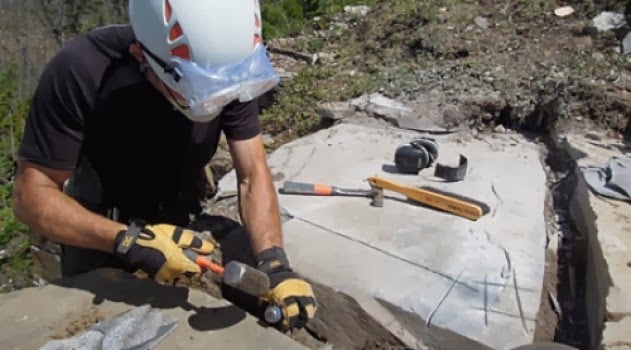
Yoho National Park’s 505-million-year-old Burgess Shale — home to some of the planet’s earliest animals, including a very primitive human relative — is one of the world’s most important fossil sites. Now, more than a century after its discovery, a compelling sequel has been unearthed: 42 kilometres away in Kootenay National Park, a new Burgess Shale fossil bed has been located that appears to equal the importance of the original discovery, and may one day even surpass it.
A paper published today in the scientific journal Nature Communications describes Kootenay National Park’s new ‘Marble Canyon’ fossil beds for the first time. The authors suggest that the area and its extraordinary fossils will greatly further our understanding of the sudden explosion of animal life during the Cambrian Period.
The find was made in the summer of 2012 by a team from the Royal Ontario Museum (ROM, Jean-Bernard Caron), Pomona College (Robert Gaines), the University of Toronto (Jean-Bernard Caron, Cédric Aria), the University of Saskatchewan (Gabriela Mángano) and Uppsala University (Michael Streng).
“This new discovery is an epic sequel to a research story that began at the turn of the previous century. There is no doubt in my mind that this new material will significantly increase our understanding of early animal evolution,” said Dr. Jean-Bernard Caron, Curator of Invertebrate Paleontology at the ROM, Associate Professor at the University of Toronto and the study’s lead author. “The rate at which we are finding animals — many of which are new — is astonishing, and there is a high possibility that we’ll eventually find more species here than at the original Yoho National Park site, and potentially more than from anywhere else in the world.”
In a short 15-day field season, the researchers collected thousands of specimens representing more than 50 species, several of which were new to science. Incredibly, many of the species previously known from Yoho are better preserved in Kootenay, retaining very fine, never-before-seen anatomical details that are important for understanding the shape of the animal ‘family tree.’
The new site parallels Yoho in its spectacular richness of arthropods, a group that today represents more than 80% of all living animals, including insects, spiders and lobsters.
Another curious similarity between Marble Canyon and the original discovery is that both sites would still be buried today if not for the dedicated exploratory work of scientists.
In 1909, world-renowned paleontologist Charles Walcott spent a summer exploring Yoho National Park’s mountainous topography in search of hidden treasures, only to stumble upon what he would later name the Burgess Shale on the final day of his field season on August 29. Similarly, in 2012, a ROM field expedition led by Caron spent part of their summer in search of the next big paleontological discovery.
“We were already aware of the presence of some Burgess Shale fossils in Kootenay National Park,” said Dr. Robert Gaines, a geologist from Pomona College, who along with Caron and colleagues had spent August 2008 at a much smaller fossil deposit in the park located near Stanley Glacier. “We had a hunch that if we followed the formation along the mountain topography into new areas with the right rock types, maybe, just maybe, we would get lucky — though we never in our wildest dreams thought we’d track down a motherload like this.”
Just like Walcott a century before, a hunch led Caron and his team to a talus slope high in the Canadian Rockies. Along this rocky slope they found a startling variety of fossils that immediately caught their attention. The researchers then pinpointed the source of the fossils to higher up on the slopes and began to excavate the fossils layer-by-layer.
“It didn’t take us very long at all to realize that we had dug up something special,” added Gaines. “To me, the Burgess Shale is a grand tale in every way imaginable, and we are incredibly proud to be part of this new chapter and to keep the story alive and thriving in everyone’s imagination.”
“We are very excited to go back to the field this summer,” said Caron. “One of our main goals is to discover more new species.”
The new fossil site is protected by Parks Canada, with the exact location remaining confidential to protect its integrity. Future visitor opportunities have not been ruled out.
Burgess Shale facts:
• This new finding is the latest in a recent string of Burgess Shale discoveries, including confirmation that Pikaia, found only in Yoho National Park, is the most primitive known vertebrate and therefore the ancestor of all descendant vertebrates, including humans.
• In over 100 years of research, approximately 200 animal species have been identified at the original Burgess Shale discovery in Yoho National Park in over 600 field days. In just 15 days of field collecting, 50 animal species have already been unearthed at the new Kootenay National Park site.
• Some species found at the new Kootenay site are also found in China’s famous Chengjiang fossil beds, which are 10 million years older. This contributes to the pool of evidence suggesting that the local and worldwide distribution of Cambrian animals, as well as their longevity, might have been underestimated.
• The original Burgess Shale site in Yoho National Park was recognized in 1980 as one of Canada’s first UNESCO World Heritage Sites. Now protected under the larger Rocky Mountain Parks UNESCO World Heritage Site, the Burgess Shale attracts thousands of visitors to Yoho National Park each year for guided hikes to the restricted fossil beds from July to September. Both Parks Canada and the Burgess Shale Geoscience Foundation lead hikes to the fossils.
• All the Burgess Shale fossil specimens in the Marble Canyon area of were collected under a Parks Canada Research and Collection permit and are held in trust for Parks Canada at the Royal Ontario Museum in Toronto.










